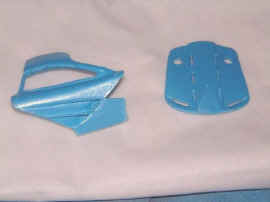|
||||||||||||||||||||
|
I first got into 1/43rd scale models about a year ago. I'd been building 1/24th scale plastic cars for years, but the lack of many of my favourite cars was frustrating. Where was the Ford RS200, the Lancia Stratos in Alitalia colours, the Lancia Delta S4, Clark's Lotus 49? I turned to the internet and soon stumbled across several websites selling kits of a range of cars, the breadth of which I could scarcely believe. At first I was sceptical, I mean how detailed could a Matchbox sized car really be? I ordered a couple of my favourite cars and found out just how detailed these kits were. Recently I decided to build a Mclaren F1 GTR, preferably one of the Le Mans cars. A quick search revealed that there were several kits of this car, and the Renaissance Gulf sponsored GTR '97 model looked promising due to the open door. The kit was ordered and arrived a few weeks later.
Checking all the bits I laid out all the parts and took a good look at what was there. The majority of the components were resin, with turned aluminium parts for the wheels, exhausts and the fire extinguisher, a white metal roll cage and rear wing and 4 frets of photo-etched parts. The instructions for 43rd scale kits were the biggest shock when I started building. In 24th scale models every component is shown, every colour is listed and step-by-step instructions and diagrams take you through every step of assembly. In 43rd scale you get a couple of black & white photo-copied sheets with a rough indication of where the parts go. The Renaissance instructions were average for this type of kit, 4 black & white sheets including a parts list/colour guide, some assembly diagrams and a decal placement guide.
The resin parts were all very nicely cast, the body and chassis were particularly good, virtually no pinholes and only a small amount of cleaning was required . The chassis actually had the engine block and air intake moulded into it although none of this detail could be seen when the body was fitted, then an idea took shape. I could cut open the engine cover to reveal the detail underneath and in the process add a little individuality to the model.
The conversion process
The Body shell This particular car had a 3 tone paint job, a fluorescent orange stripe down the centre, blue deck and metallic brown sides and rear, obviously some masking was going to be necessary. The orange stripe was provided as a decal so, after washing the shell, I proceeded to spray the entire body in blue.
A bit of careful masking and I was ready to spray the metallic brown for the sides, the instructions gave a reference for this colour but rather than use the automotive paint I got a sample and mixed up some acrylics to match it. I prefer to use acrylics where possible, automotive laquers just don't agree with me. A mix of Tamiya Gloss Red (X-7) and Tamiya Gloss Black (X-10) in a ratio of 2:1 gave the right tone and the addition of Tamiya Flat Aluminium (XF-16) in a ratio of 5:1 gave the metallic edge I wanted. After spraying and removing the mask the body was starting to look like the real thing (pic10), the sides look almost black in the photo but in real life they were a very deep brown.
The next stage was to apply the fluorescent orange decals to the body, starting with the wide stripe that runs the length of the car. The nose and tail sections went on easily (although the tail stripe had to be cut to fit on the removed engine cover) but the section that fitted over the roof intake would not bed down properly. No matter how much Micro-Sol I slapped on it I couldn't get rid of those horrible wrinkles. After several, increasingly frustrating, attempts I gave up and dumped the whole thing in a jar of brake fluid to soak overnight.
Back to the chassis
The dashboard decals were then applied and the steering wheel attached.
The turned aluminium tail pipes were then fitted into their appropriate positions on the back of the chassis, completing the chassis assembly. Finishing the body By this time the paint on the body had cured so after painting the window frames and interior in matt black it was on with the decals. The rest of the decals were applied with no problems, although many of the decals on the right side of the car had to be cut into sections because of the open door.
The number decal and the union flag that were applied over the vents on the front wings were cut into individual strips and applied one at a time. Some what time consuming but the end effect is very nice. Once all of the decals were applied the door was attached and 2 small slots were cut into the roof to allow the engine cover to be mounted.
No amount a jiggling could get the chassis into the body at a shallow enough angle to allow the exhausts to pass through the slots. In the end I removed the exhausts, fitted the body and re-fitted the exhausts with the body in place.
Overall the kit went together fairly easily, apart from the weird fit on the dash, the roof intake decal not bedding down and the exhaust pipes, no real problems were encountered and I think the end result is a very nice looking model, especially with the additional detail of the open engine cover.
|




















